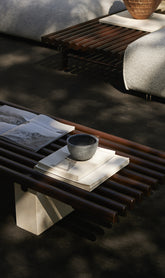
Arne Jacobsen
Arne Jacobsen (1902-1971) was born at the beginning of the 19th century in Copenhagen.
Architect and designer, he was undoubtedly one of the most important and well-known figures of Danish design in the world.
An exponent of European functionalism, he masterfully combined the more formal aspects of products with a special attention to aesthetics and the organic world. He was one of the most prominent names in 20th century design, alongside Le Corbusier and Charles Eames.
His education in architecture started in 1924 when he began studies at the faculty of architecture in the Royal Danish Academy of Fine Arts in Copenhagen from which he graduated in 1927.
He managed to distinguish himself and be noticed outside of Denmark by demonstrating his strong aptitude for design already during the period of his studies. In fact at only 23 years of age in 1925, he won the silver medal at the Exposition International des Art Décoratifs in Paris. He presented a chair with pure, simple lines that enhanced the natural material with which it had been created. The style that therefore would become the distinguishing feature of his design had already emerged: function enhanced by pure simplicity.
Afterwards, a trip to Germany allowed him to become better acquainted with and be closer to Le Corbusier, Walter Gropius and Ludwing Mis van der Rohe, and inevitably be under their influence.
His curiosity and design skills led him to harmoniously integrate the avant-garde currents of his time, such as Bauhaus, with the classic Danish tradition in which he was born and educated.
Starting with the 1930s, he opened his own professional studio and collaborated in producing furnishings he created with manufacturers Fritz Hansen and Louis Poulsen.
His creative ability was earmarked by an open-mindedness and desire for experimentation which urged him to excel in grasping all the conceptual and formal aspects that distinguished the international panorama of his time throughout his career, integrating them with typical aspects of Nordic design resulting in timeless objects.
In fact, his projects as a designer are and will forever remain in design history, products that will never be outdated. Capable of transcending the perception of the era, they become icons that fit superlatively into contemporary living owing to their innovative appeal.
Timeless icons of innovation, style and passion.
Sorry, there are no products in this collection.
You've viewed 0 of 0 products
